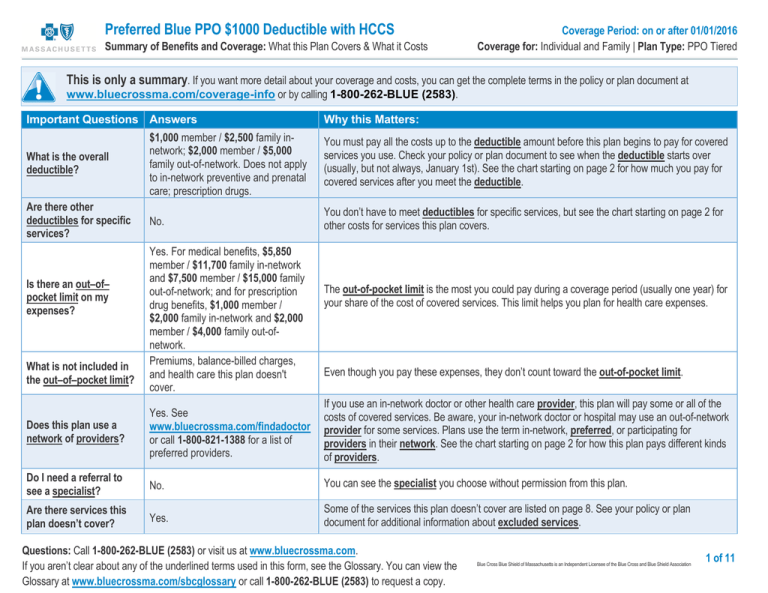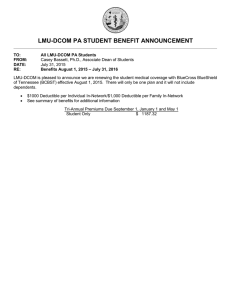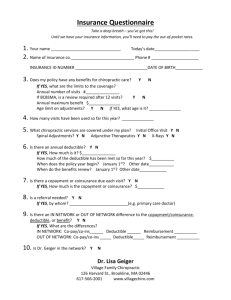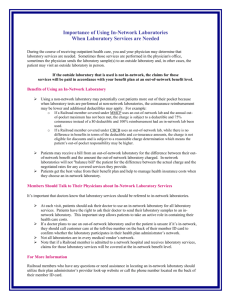Preferred Blue PPO $1000 Deductible with HCCS
advertisement

Preferred Blue PPO $1000 Deductible with HCCS Summary of Benefits and Coverage: What this Plan Covers & What it Costs Coverage Period: on or after 01/01/2016 Coverage for: Individual and Family | Plan Type: PPO Tiered This is only a summary. If you want more detail about your coverage and costs, you can get the complete terms in the policy or plan document at www.bluecrossma.com/coverage-info or by calling 1-800-262-BLUE (2583). Important Questions Answers Why this Matters: What is the overall deductible? $1,000 member / $2,500 family innetwork; $2,000 member / $5,000 family out-of-network. Does not apply to in-network preventive and prenatal care; prescription drugs. You must pay all the costs up to the deductible amount before this plan begins to pay for covered services you use. Check your policy or plan document to see when the deductible starts over (usually, but not always, January 1st). See the chart starting on page 2 for how much you pay for covered services after you meet the deductible. Are there other deductibles for specific services? No. You don’t have to meet deductibles for specific services, but see the chart starting on page 2 for other costs for services this plan covers. Is there an out–of– pocket limit on my expenses? What is not included in the out–of–pocket limit? Yes. For medical benefits, $5,850 member / $11,700 family in-network and $7,500 member / $15,000 family out-of-network; and for prescription drug benefits, $1,000 member / $2,000 family in-network and $2,000 member / $4,000 family out-ofnetwork. Premiums, balance-billed charges, and health care this plan doesn't cover. The out-of-pocket limit is the most you could pay during a coverage period (usually one year) for your share of the cost of covered services. This limit helps you plan for health care expenses. Even though you pay these expenses, they don’t count toward the out-of-pocket limit. Does this plan use a network of providers? Yes. See www.bluecrossma.com/findadoctor or call 1-800-821-1388 for a list of preferred providers. If you use an in-network doctor or other health care provider, this plan will pay some or all of the costs of covered services. Be aware, your in-network doctor or hospital may use an out-of-network provider for some services. Plans use the term in-network, preferred, or participating for providers in their network. See the chart starting on page 2 for how this plan pays different kinds of providers. Do I need a referral to see a specialist? No. You can see the specialist you choose without permission from this plan. Are there services this plan doesn’t cover? Yes. Some of the services this plan doesn’t cover are listed on page 8. See your policy or plan document for additional information about excluded services. Questions: Call 1-800-262-BLUE (2583) or visit us at www.bluecrossma.com. If you aren’t clear about any of the underlined terms used in this form, see the Glossary. You can view the Glossary at www.bluecrossma.com/sbcglossary or call 1-800-262-BLUE (2583) to request a copy. Blue Cross Blue Shield of Massachusetts is an Independent Licensee of the Blue Cross and Blue Shield Association 1 of 11 Copayments are fixed dollar amounts (for example, $15) you pay for covered health care, usually when you receive the service. Coinsurance is your share of the costs of a covered service, calculated as a percent of the allowed amount (or provider’s charge if it is less than the allowed amount) for the service. For example, if the plan’s allowed amount for an overnight hospital stay is $1,000 (and it is less than the provider’s charge), your coinsurance payment of 20% would be $200. This may change if you haven’t met your deductible. The amount the plan pays for covered services is based on the allowed amount. If an out-of-network provider charges more than the allowed amount, you may have to pay the difference. For example, if an out-of-network hospital charges $1,500 for an overnight stay and the allowed amount is $1,000, you may have to pay the $500 difference. (This is called balance billing.) This plan may encourage you to use in-network lowest cost share providers by charging you lower deductibles, copayments and coinsurance amounts. (If you are eligible to elect a Health Reimbursement Account (HRA), Flexible Spending Account (FSA) or you have elected a Health Savings Account (HSA), you may have access to additional funds to help cover certain out-of-pocket expenses such as copayments, coinsurance, deductibles and costs related to services not otherwise covered.) Common Medical Event Services You May Need Your cost if you use In-Network In-Network Out-ofLowest Highest Network Cost Share Cost Share Limitations & Exceptions Deductible applies first; in-network cost share waived for the first two diabetic PCP and / or specialist visits per calendar year Deductible applies first; in-network cost share waived for the first two diabetic PCP and / or specialist visits per calendar year Primary care visit to treat an injury or illness $25 / visit $25 / visit 20% coinsurance Specialist visit $25 / visit $25 / visit 20% coinsurance $25 / chiropractor visit $25 / chiropractor visit 20% coinsurance / chiropractor visit Deductible applies first No charge 20% coinsurance Deductible applies first for out-ofnetwork; limited to age-based schedule and / or frequency If you visit a health care provider’s office or clinic Other practitioner office visit Preventive care/screening/immunization No charge 2 of 11 Common Medical Event Services You May Need Diagnostic test (x-ray, blood work) If you have a test Imaging (CT/PET scans, MRIs) Your cost if you use In-Network In-Network Out-ofLowest Highest Network Cost Share Cost Share $125 for x-rays and $60 for labs for 20% $25 hospitals; $25 coinsurance for other providers $525 for hospitals; $75 20% $75 for other coinsurance providers Limitations & Exceptions Deductible applies first; copayment applies per category of test / day Deductible applies first; copayment applies per category of test / day 3 of 11 Common Medical Event Services You May Need Generic drugs If you need drugs to treat your illness or condition More information about prescription drug coverage is available at www.bluecrossma.com/m Preferred brand drugs edications. Non-preferred brand drugs Specialty drugs Your cost if you use In-Network In-Network Limitations & Exceptions Out-ofLowest Highest Network Cost Share Cost Share $20 / retail $20 / retail supply or $40 supply or $40 ($20 for value ($20 for value $40 / retail drugs) / mail drugs) / mail supply for lowservice supply service supply Up to 30-day retail (90-day mail cost generic for low-cost for low-cost drugs or $80 / service) supply; cost share may be generic drugs; generic drugs; retail supply for waived for certain covered drugs and $40 / retail $40 / retail other generic supplies; pre-authorization required supply or $80 supply or $80 for certain drugs drugs and all ($40 for value ($40 for value charges for drugs) / mail drugs) / mail mail service service supply service supply for other for other generic drugs generic drugs $60 / retail $60 / retail Up to 30-day retail (90-day mail $120 / retail supply or $120 supply or $120 service) supply; cost share may be supply and all ($60 for value ($60 for value waived for certain covered drugs and charges for drugs) / mail drugs) / mail supplies; pre-authorization required mail service service supply service supply for certain drugs Up to 30-day retail (90-day mail $120 / retail $120 / retail $240 / retail service) supply; cost share may be supply or $360 supply or $360 supply and all waived for certain covered drugs and / mail service / mail service charges for supplies; pre-authorization required supply supply mail service for certain drugs Applicable cost Applicable cost When obtained from a designated share (generic, share (generic, specialty pharmacy; preNot covered preferred, non- preferred, nonauthorization required for certain preferred) preferred) drugs 4 of 11 Common Medical Event If you have outpatient surgery Services You May Need Facility fee (e.g., ambulatory surgery center) Physician/surgeon fees If you need immediate medical attention Your cost if you use In-Network In-Network Out-ofLowest Highest Network Cost Share Cost Share $1,000 / admission for 20% No charge hospitals; no coinsurance charge for other providers 20% No charge No charge coinsurance Emergency room services $150 / visit $150 / visit $150 / visit Emergency medical transportation No charge No charge No charge Urgent care $25 / visit $25 / visit Facility fee (e.g., hospital room) No charge $1,000 / admission Physician/surgeon fee No charge No charge If you have a hospital stay 20% coinsurance 20% coinsurance 20% coinsurance Limitations & Exceptions Deductible applies first Deductible applies first In-network deductible applies first for in-network and out-of-network services; copayment waived if admitted or for observation stay In-network deductible applies first for in-network and out-of-network services Deductible applies first Deductible applies first; preauthorization required Deductible applies first; preauthorization required 5 of 11 Common Medical Event Services You May Need Mental/Behavioral health outpatient services Mental/Behavioral health inpatient services If you have mental health, behavioral health, or substance abuse needs Substance use disorder outpatient services Substance use disorder inpatient services Prenatal and postnatal care Your cost if you use In-Network In-Network Out-ofLowest Highest Network Cost Share Cost Share Limitations & Exceptions Deductible applies first; preauthorization required for certain services $25 / visit $25 / visit 20% coinsurance No charge No charge or $1,000 / admission for general hospitals 20% coinsurance Deductible applies first; preauthorization required $25 / visit $25 / visit 20% coinsurance Deductible applies first; preauthorization required for certain services No charge No charge or $1,000 / admission for general hospitals 20% coinsurance Deductible applies first; preauthorization required for certain services No charge No charge 20% coinsurance Deductible applies first for in-network postnatal care and out-of-network prenatal and postnatal care No charge $1,000 / admission for general hospitals and no charge for delivery 20% coinsurance Deductible applies first If you are pregnant Delivery and all inpatient services 6 of 11 Common Medical Event Services You May Need Home health care Rehabilitation services If you need help recovering or have other special health needs Habilitation services No charge No charge 20% coinsurance 20% coinsurance 20% coinsurance 40% coinsurance Hospice service No charge No charge 20% coinsurance Eye exam No charge No charge 20% coinsurance Not covered Not covered Not covered No charge No charge Not covered Skilled nursing care Durable medical equipment If your child needs dental or eye care Your cost if you use In-Network In-Network Out-ofLowest Highest Network Cost Share Cost Share 20% No charge No charge coinsurance $60 / visit for general 20% $25 / visit hospitals; $25 / coinsurance visit for other providers $60 / visit for general 20% $25 / visit hospitals; $25 / coinsurance visit for other providers Glasses Dental check-up Limitations & Exceptions Deductible applies first; preauthorization required Deductible applies first; limited to 60 visits per calendar year (other than for autism, home health care, and speech therapy) Deductible applies first; rehabilitation therapy coverage limits apply; cost share and coverage limits waived for early intervention services for eligible children Deductible applies first; limited to 100 days per calendar year; preauthorization required Deductible applies first; in-network cost share waived for one breast pump per birth (20% coinsurance for out-of-network) Deductible applies first; preauthorization required for certain services Deductible applies first for out-ofnetwork; limited to one exam every 24 months --- none --Limited to members under age 19, twice in 12 months 7 of 11 Excluded Services & Other Covered Services: Services Your Plan Does NOT Cover (This isn’t a complete list. Check your policy or plan document for other excluded services.) Acupuncture Children's glasses Cosmetic surgery Dental care (adult) Long-term care Private-duty nursing Other Covered Services (This isn’t a complete list. Check your policy or plan document for other covered services and your costs for these services.) Bariatric surgery Chiropractic care Hearing aids ($2,000 per ear every 36 months for members age 21 or younger) Infertility treatment Non-emergency care when traveling outside the U.S. Routine eye care - adult (one exam every 24 months) Your Rights to Continue Coverage: If you have Individual health insurance: Federal and State laws may provide protections that allow you to keep this health insurance coverage as long as you pay your premium. There are exceptions, however, such as if: You commit fraud The insurer stops offering services in the State You move outside the coverage area For more information on your rights to continue coverage, you can contact the Member Service number listed on your ID card or call 1-800-262-BLUE (2583). You may also contact your state insurance department at www.mass.gov/doi. OR Routine foot care (only for patients with systemic circulatory disease) Weight loss programs (three months in qualified program(s) per contract per calendar year) If you have Group health coverage: If you lose coverage under the plan, then, depending upon the circumstances, Federal and State laws may provide protections that allow you to keep health coverage. Any such rights may be limited in duration and will require you to pay a premium, which may be significantly higher than the premium you pay while covered under the plan. Other limitations on your rights to continue coverage may also apply. For more information on your rights to continue coverage, contact your plan sponsor. Note: A plan sponsor is usually the member’s employer or organization that provides group health coverage to the member. You may also contact your state insurance department, the U.S. Department of Labor, Employee Benefits Security Administration at 1-866-444-3272 or www.dol.gov/ebsa, or the U.S. Department of Health and Human Services at 1-877-267-2323 x61565 or www.cciio.cms.gov. 8 of 11 Your Grievance and Appeals Rights: If you have a complaint or are dissatisfied with a denial of coverage for claims under your plan, you may be able to appeal or file a grievance. For questions about your rights, this notice, or assistance, you can contact the Member Service number listed on your ID card or contact your plan sponsor. Note: A plan sponsor is usually the member’s employer or organization that provides group health coverage to the member. You may also contact The Office of Patient Protection at 1‑800-436-7757 or www.mass.gov/hpc/opp. Does this Coverage Provide Minimum Essential Coverage? The Affordable Care Act requires most people to have health care coverage that qualifies as “minimum essential coverage.” This plan or policy does provide minimum essential coverage. Does this Coverage Meet the Minimum Value Standard? The Affordable Care Act establishes a minimum value standard of benefits of a health plan. The minimum value standard is 60% (actuarial value). This health coverage does meet the minimum value standard for the benefits it provides. Disclaimer: This document contains only a partial description of the benefits, limitations, exclusions and other provisions of this health care plan. It is not a policy. It is a general overview only. It does not provide all the details of this coverage, including benefits, exclusions and policy limitations. In the event there are discrepancies between this document and the policy, the terms and conditions of the policy will govern. ––––––––––––––––––––––To see examples of how this plan might cover costs for a sample medical situation, see the next page.–––––––––––––––––––––– 9 of 11 About these Coverage Examples: These examples show how this plan might cover medical care in given situations. Use these examples to see, in general, how much financial protection a sample patient might get if they are covered under different plans. This is not a cost estimator. Don’t use these examples to estimate your actual costs under this plan. The actual care you receive will be different from these examples, and the cost of that care will also be different. See the next page for important information about these examples. Having a baby Managing type 2 diabetes (normal delivery) (routine maintenance of a well-controlled condition) Amount owed to providers: $7,540 Plan pays $6,370 Patient pays $1,170 Sample care costs: Hospital charges (mother) Routine obstetric care Hospital charges (baby) Anesthesia Laboratory tests Prescriptions Radiology Vaccines, other preventive Total Patient pays: Deductibles Copays Coinsurance Limits or exclusions Total Amount owed to providers: $5,400 Plan pays $3,280 Patient pays $2,120 $2,700 $2,100 $900 $900 $500 $200 $200 $40 $7,540 $1,000 $20 $0 $150 $1,170 Sample care costs: Prescriptions Medical Equipment and Supplies Office Visits and Procedures Education Laboratory tests Vaccines, other preventive Total $2,900 $1,300 $700 $300 $100 $100 $5,400 Patient pays: Deductibles Copays Coinsurance Limits or exclusions Total $1,000 $1,040 $0 $80 $2,120 10 of 11 Questions and answers about the Coverage Examples: What are some of the assumptions behind the Coverage Examples? Costs don’t include premiums. Sample care costs are based on national averages supplied by the U.S. Department of Health and Human Services, and aren’t specific to a particular geographic area or health plan. The patient’s condition was not an excluded or preexisting condition. All services and treatments started and ended in the same coverage period. There are no other medical expenses for any member covered under this plan. Out-of-pocket expenses are based only on treating the condition in the example. The patient received all care from in-network lowest cost share providers. If the patient had received care from other in-network or out-ofnetwork providers, costs would have been higher. What does a Coverage Example show? For each treatment situation, the Coverage Example helps you see how deductibles, copayments, and coinsurance can add up. It also helps you see what expenses might be left up to you to pay because the service or treatment isn’t covered or payment is limited. Does the Coverage Example predict my own care needs? No. Treatments shown are just examples. The care you would receive for this condition could be different based on your doctor’s advice, your age, how serious your condition is, and many other factors. Does the Coverage Example predict my future expenses? No. Coverage Examples are not cost Can I use Coverage Examples to compare plans? Yes. When you look at the Summary of Benefits and Coverage for other plans, you’ll find the same Coverage Examples. When you compare plans, check the “Patient Pays” box in each example. The smaller that number, the more coverage the plan provides. Are there other costs I should consider when comparing plans? Yes. An important cost is the premium you pay. Generally, the lower your premium, the more you’ll pay in out-of-pocket costs, such as copayments, deductibles, and coinsurance. You should also consider contributions to accounts such as health savings accounts (HSAs), flexible spending arrangements (FSAs) or health reimbursement accounts (HRAs) that help you pay out-of-pocket expenses. estimators. You can’t use the examples to estimate costs for an actual condition. They are for comparative purposes only. Your own costs will be different depending on the care you receive, the prices your providers charge, and the reimbursement your health plan allows. Questions: Call 1-800-262-BLUE (2583) or visit us at www.bluecrossma.com. If you aren’t clear about any of the underlined terms used in this form, see the Glossary. You can view the Glossary at www.bluecrossma.com/sbcglossary or call 1-800-262-BLUE (2583) to request a copy. ® Registered Marks of the Blue Cross and Blue Shield Association.© 2016 Blue Cross and Blue Shield of Massachusetts, Inc., and Blue Cross and Blue Shield of Massachusetts HMO Blue, Inc. 800051HR_Preferred_Blue_Ded_1000 80-0211HCCSSG1-1-16 11 of 11 MCC Compliance This health plan meets Minimum Creditable Coverage Standards for Massachusetts residents that went into effect as of January 1, 2014, as part of the Massachusetts Health Care Reform Law. Blue Cross Blue Shield of Massachusetts is an Independent Licensee of the Blue Cross and Blue Shield Association. ® Registered Marks of the Blue Cross and Blue Shield Association. © 2015 Blue Cross and Blue Shield of Massachusetts, Inc., and Blue Cross and Blue Shield of Massachusetts HMO Blue, Inc. #139512BS 55-0647 (6/14) 150M Pediatric Dental Your health plan coverage includes a dental policy that covers pediatric dental services as required under the federal Patient Protection and Affordable Care Act. Blue Cross Blue Shield of Massachusetts is an Independent Licensee of the Blue Cross and Blue Shield Association. ® Registered Marks of the Blue Cross and Blue Shield Association. © 2015 Blue Cross and Blue Shield of Massachusetts, Inc., and Blue Cross and Blue Shield of Massachusetts HMO Blue, Inc. 55-0613 (9/14) 10M Information About the Plan This health plan option includes a tiered network feature called Hospital Choice Cost Sharing. As a member in this plan, you will pay different levels of in-network cost share (such as copayments and coinsurance) for certain services depending on the preferred general hospital you choose to furnish those covered services. For most preferred general hospitals, you will pay the lowest in-network cost sharing level. However, if you receive certain covered services from some preferred general hospitals, you pay the highest in-network cost sharing level. A preferred general hospital’s cost sharing level may change from time to time. Overall changes to add another preferred general hospital to the highest cost sharing level will happen no more than once each calendar year. For help in fnding a preferred general hospital for which you pay the lowest in-network cost sharing level, check the most current provider directory for your health plan option or visit the online provider search tool at www.bluecrossma.com/hospitalchoice. Then click on the Planning Guide link on the left navigation to download a printable network hospital list or to access the provider search page. Blue Cross Blue Shield of Massachusetts is an Independent Licensee of the Blue Cross and Blue Shield Association. ® Registered Marks of the Blue Cross and Blue Shield Association. © 2015 Blue Cross and Blue Shield of Massachusetts, Inc., and Blue Cross and Blue Shield of Massachusetts HMO Blue, Inc. #139504BS 55-0531 (6/14) 5M Limited, Regional and Tiered Network Plans: Choosing the Health Plan That’s Right for You Health Insurance & Provider Networks Massachusetts health insurers now offer lower-­‐cost health insurance plan options with limited, regional and tiered networks. This guide can help you get the information you need to understand these options and make an informed decision. Many insurers have different health plans with different provider networks. A doctor or hospital may be in the provider network of one plan but not in another, even though the same insurer sells both health plans. The provider network determines the doctors and hospitals the health plan will cover for non-­‐emergency care. Some health plans will not cover services you receive from providers that are outside the network without approval, while others will have you pay higher out-­‐of-­‐ pocket costs if you go out of network. Your choice of health plan and provider network will determine your premium and out-­‐of-­‐pocket costs. You may be able to save money on your premium if you choose a network with more limits on the doctors and hospitals that are covered. It is important for you to know the provider network for any plan you are considering. Insurers have brand names for their plans and networks. Make sure you know the brand names so that you can find out if your provider is part of that specific plan. You can find the provider directory on the health insurer’s website or you can ask for a paper copy of the directory. Also, use the directory to make sure that the particular location used by your provider is included in the network. Be sure to call the insurance carrier if you have any questions about whether a provider is in a network. State law now requires insurers to label any limited network as: • Limited Provider Network • Regional Provider Network • Tiered Provider Network Remember, once you buy a health plan, you cannot switch plans until it is up for renewal, so think about your options and health care needs carefully. Why Choose a Health Plan with a Limited Network? Buying a product with some type of limited network allows you to have similar coverage and quality care at a cost that is lower than that of other plans offered by the same insurer. What Does a Network’s Size have to do with Cost? Limited networks can lower health insurance premiums. They allow insurers to reduce costs by limiting the group of health care providers to those that offer quality care at lowers costs compared to higher-­‐cost providers. A provider or health care facility may leave a network or might be assigned to a different tier in a tiered provider network. Find out how often and when the network changes -­ and how you can check a provider’s status. Types of Provider Networks You should know that all network plans licensed in Massachusetts have a full range of quality health services and providers. Choosing a limited network does not mean that you will have to settle for lower quality care. Insurers may offer plans that use a combination of the network designs described below, and it is important for you to read your plan description to learn the rules of each network. General Provider Network Limited Provider Network Regional Provider Tiered Provider Network Plans give you the widest Plans have a network that is Network Plans have a Plans assign providers to choice of providers. This smaller than the insurer’s network that is limited to a different levels (tiers) based may be a good option for you general network, but cost specific geographic region, on the insurer’s decision of if you are willing to pay more less. This may be a good and usually cost less than a the relative value of the for a wider choice of option for you if the limited general network. This may provider’s cost and quality. providers. network includes the be a good option for you if Your share of the cost will providers that you plan to you live or work in a region depend on the provider’s use and you do not need the that the network covers and tier. With this plan, you can option to visit providers you do not need the option save money by choosing outside the network. of visiting providers in other providers in a lower-­‐cost areas. tier. General Limited Regional Tiered Choosing the Right Network: Key Questions to Ask Network Network Network Network Are the providers and facilities that you use listed in the insurer’s network directory? -­The insurer will have a directory that lists the providers in each of its networks. Check to see that the hospital, primary care provider and specialists you want to see or might be referred to your provider are specifically listed for the services you use at the locations you want. Are you willing to change providers or facilities in order to pay a lower premium? -­If you are able to switch to providers that are in a limited network you may be able to get lower premiums. Remember that if you want to see a provider that is not listed in the network, you may need to pay higher out-­of-­pocket costs or you may not have coverage at all for those providers. Are you willing to limit yourself to providers and facilities near your home or work? -­If you don’t need the option of traveling to hospitals in another area for your care, you may be able to get lower premiums. Remember that care at an out-­of-­network provider or hospital may not be covered, or you may need to pay more for your share. Are you willing to choose a plan in which you pay more or less out of pocket depending on the tier to which your provider is assigned? -­ Do you want a broad network, and are you willing to pay a larger share of the expense for some hospitals and doctors? Remember, this could end up being more than what you may save in premium. √ √ √ √ √ √ √ √ √ √ Important Things to Remember Know the brand name of the network plan you choose – and be sure the providers you want are in that network plan. Understand the ways your share of the costs can vary – co-­‐payments, co-­‐insurance or deductibles can be higher or lower depending on the provider and the tier the provider is in. DIVISION OF INSURANCE,1000 Washington Street, Suite 810 • Boston, MA 02118-6200 (617) 521-7794 • FAX (617) 521-7758 http://www.mass.gov/doi 55-­‐0249 For Members Enrolled in a Group Health Plan Continuity of Care Access for Cancer and Pediatric Facilities If You Are Enrolled in a Group Health Plan with a Tiered Network You may be eligible for continuity of care coverage when you enroll in a tiered network plan and you are receiving an active course of care for a serious illness that you began before your effective date in the health plan. This means that under certain conditions, the cost share amount you pay for covered services furnished at a comprehensive cancer or pediatric facility will be a lower cost share amount than you would normally pay for services at that facility. To be eligible for this coverage, you must meet all of the following conditions: • You are a member enrolled in a group health plan through your employer. (Members enrolled in individual health plans are no longer eligible.) • You began an active course of care for a serious illness (such as cancer or cystic fbrosis) at a comprehensive cancer or pediatric facility before your effective date in the tiered network plan. Comprehensive cancer or pediatric facility means: Dana-Farber Cancer Institute, Boston Children’s Hospital, Shriners Hospitals for Children (Boston and Springfeld), Floating Hospital for Children at Tufts Medical Center, Nashoba Valley Medical Center, and Massachusetts Eye and Ear Infrmary. • You would normally pay the highest in-network cost-share amount for covered services furnished at the comprehensive cancer or pediatric facility where you are receiving your care; or the comprehensive cancer or pediatric facility is not in the health plan’s network. • Your active course of care, if it were disrupted, would cause you an undue hardship. This means, for example, a disruption could endanger your life, or cause you suffering or pain, or result in a substantial change to your treatment plan. If you meet all of the conditions stated above and your active course of care began on or after May 1, 2012, you are eligible for this coverage until the end of the 12-month period that starts on the subscriber’s effective date in a tiered network plan, but only when your group offers you a choice to enroll only in a tiered network plan in which your comprehensive cancer or pediatric facility is at the highest in-network cost share level or it is not part of the health plan’s network; and your care is not available from another provider in the health plan’s network. If Blue Cross Blue Shield determines you are eligible for this coverage, your cost share amount will be at the second highest in-network cost share level when the comprehensive cancer or pediatric facility is at the highest cost share level. Or, your cost share amount will be at the lowest in-network cost share level when the comprehensive cancer or pediatric facility is not part of the health plan’s network. If Blue Cross Blue Shield determines you are not eligible for this coverage, you must pay the cost share amount you would normally pay for covered services furnished at a comprehensive cancer or pediatric facility. If you think you are eligible for this coverage, you or your health care provider must send a completed continuity of care form to Blue Cross Blue Shield. You can get a copy of this form by calling member service at the toll-free phone number shown on your ID card. Or, visit Member Central, and in the Tools and Resources menu, select Forms and Brochures. Then click Health Plans—Miscellaneous and download the Continuity of Care Form for Plans That Include a Tiered Provider Network. Blue Cross Blue Shield of Massachusetts is an Independent Licensee of the Blue Cross and Blue Shield Association. ® Registered Marks of the Blue Cross and Blue Shield Association. © 2015 Blue Cross and Blue Shield of Massachusetts, Inc., and Blue Cross and Blue Shield of Massachusetts HMO Blue, Inc. #139511BS 55-0646 (6/14) 2M




